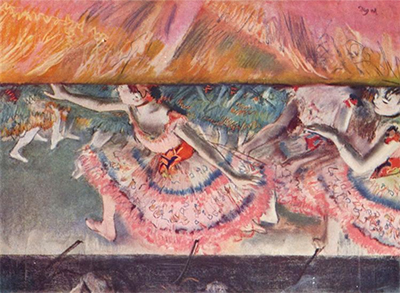The beautiful artwork originally titled Le Rideau Tombe translates evidently to Lowering The Curtain.
The stunning piece produced by artist Edgar Degas captivates lovely movement throughout his work as he gives the viewer a glimpse into his view out towards the world. The artist is well known for imitating grace and the arts throughout his paintings in the focus of Ballet. Edgar Degas is prominently known as a captivating artist that adored showcasing the many wonders he witnessed throughout his life.
The painting, Lowering The Curtain, gives the viewer a swift glimpse of a moment that seized the artist. Degas attended numerous social outings to the opera, performances, restaurants, and most notably the ballet. He felt a need to illustrate the beauty he saw during the outings throughout his work. Lowering The Curtain perfectly captures the artist's fascination with what goes on behind the scenes when others do not pay attention.
The painting depicts numerous ballerinas running in opposite directions towards the left and right. The focal point figure that captures the viewer's attention is the woman near the centre of the frame to the right. She quickly throws her right arm towards her with her left arm towards the opposite direction. The ballerina lunges forward and placed her left leg in front of her. Her right leg is pointed towards the floor near the back of her body as she pushes away.
The focal ballerina's body is bent forward as she eludes her body in the direction quickly. The ballerina does not hold any element of grace as it seems her number has ended, and she is quickly attempting to get off stage. The other ballerina to her right whose face is evident to the viewer is heading towards the same direction as the focal ballerina.
However, this woman has an element of grace in her face as she still acts for the audience. While the focal ballerina’s arm is lounged forward, the other woman’s arm is still graceful while she finishes the number. There’s two women are captivated by different energies as they run off stage and prepare for the next part of the show.
The stunning element that truly captures the viewer's attention is the magnificent detailing of north ballerina’s costumes. A classic off the collar bone corset is worn in a gentle salmon colour. A brighter orange design covers their shoulders. Towards the waist of the woman, an orange belt ties the skirt and corset together as one unity. The belt has a large bow on it facing the front of the women's waist. The stunning element that absolutely captures the viewer is the beautiful large skirt that flows towards the ground. This white puffy pink skirt is a tad longer than the usual skirts worn by ballerinas at the time. The large romantic tutu burns open in endless layers of ruffled shifting and texture. A layer of blue fabric covers rows of the skirt, finally falling into a classic ruffle. Small swirling details are evident throughout the light shades of fabric on the skirt.
If the viewer looks towards the back of the stage, the bottom half of blue ballerinas is evident. A number of legs and skirts fill the canvas as these ballerinas too attempt to get off stage. As there is a significant constant theme in the ballerinas costumes, it is quite evident that these women are part of the same scene. A stunning warm curtain falls towards the bottom of the stage, hiding the audience from the show. Shades of orange and pink pastels bleed into one another in soft strokes. While it's evident that Degas didn't care for the quality of the curtain, it grabs the viewer's attention through it's warm tangerine-sorbet shades.




